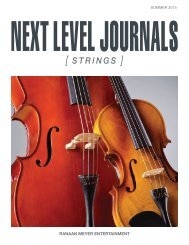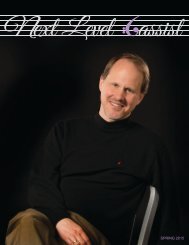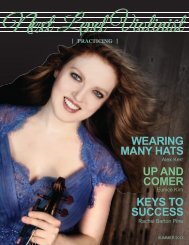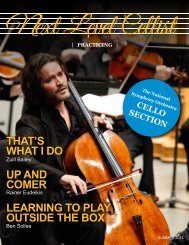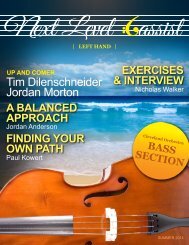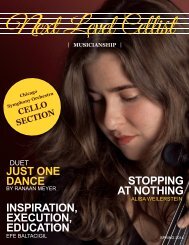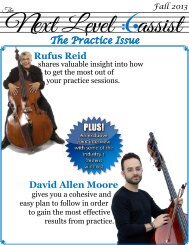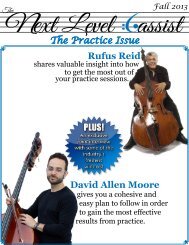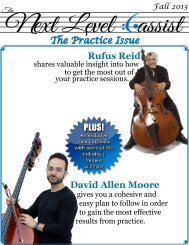Next Level Bassist Musicality Issue
Articles by Sarah Hogan and John Patitucci, Spotlight on the Pittsburgh Symphony, Double Stop Strum by Ranaan Meyer
Articles by Sarah Hogan and John Patitucci, Spotlight on the Pittsburgh Symphony, Double Stop Strum by Ranaan Meyer
Create successful ePaper yourself
Turn your PDF publications into a flip-book with our unique Google optimized e-Paper software.
Koussevitzky Concerto. I am always boggled when I have to<br />
say that in the first place, since I can’t remember NOT making<br />
music with it. I’m sure Mr. Loew said the same thing to<br />
me, which is why I remember the beautiful story he told me<br />
to conjure up an image so that I WOULD play it musically.<br />
He helped me realize the piece is a sad, angst filled love song<br />
that drives the melodies. This is another tool I try to teach<br />
my students - if the music inspires them to imagine a story<br />
“I find that singing a phrase can often<br />
help with the fluctuation of time that can<br />
be effective in creating a musical line.ˮ<br />
or an image, the musical point will be more clear. For lack<br />
of a better phrase, “Paint me a picture.”<br />
In my analytical view, there are a few big technical tools<br />
one can use to help create the above mentioned tension and<br />
pictures. Dynamics, the variance of tone, vibrato, and the<br />
fluctuation of time are a few techniques that we can use to<br />
help create a sense of music within a piece. Dynamics are a<br />
pretty cut and dry tool to use. Luckily, many composers and<br />
editors give us the general direction for these. For example,<br />
a change in dynamic can signal increasing or decreasing tension<br />
or the beginning of a new phrase. That is when those<br />
above mentioned diagrams can become particularly useful.<br />
Mapping out exactly what you as the musician are hoping to<br />
achieve as you change the “volume” level can be extremely<br />
helpful. The next and most important step is to find out if<br />
what you are doing is audible to the listener. This can be<br />
done most efficiently by recording yourself and finding out<br />
if what you are doing can be heard. In my experience, as the<br />
player you must always be more dramatic and exaggerated<br />
than you think with dynamics for them to be evident to<br />
the listener.<br />
Varying the tone you produce on the instrument can be<br />
quite helpful in creating a sense of musicality as well, and<br />
is often done in conjunction with dynamics. When I think<br />
about the point when the first movement of the Eccles Sonata<br />
goes from the minor into the major key, I think about<br />
warming up my tone. This is a great metaphor, playing<br />
something “warm” or “cold,” but what does it mean? In that<br />
case, when I go from minor to major, or cooler to warmer,<br />
not only does my dynamic increase to start the phrase, but I<br />
also am trying to use more bow, and more bow hair to create<br />
a fuller, rounder sound. In addition, it is important to think<br />
about playing the same dynamic with contrasting tones.<br />
You can play a passage forte in a myriad of ways. To play an<br />
aggressive forte sound, the player can create a harsher sound<br />
by playing closer to the bridge. To play a big, hearty Brahms<br />
passage, the player would think about using more bow and<br />
not playing quite as close to the bridge in order to find that<br />
sweet spot where the instrument sings. For the opening<br />
phrases of Mozart’s 35th Symphony, we want to create a forte<br />
sound that is strong, but somehow lighter than Brahms,<br />
most likely by playing with a bit less hair and slightly closer<br />
to the fingerboard. The same discussion can be had for all<br />
the different ways to play softly, with varying amounts of<br />
hair and bow speed.<br />
Vibrato is a great asset to us as musicians. I like to tell my<br />
students that using vibrato is like using glitter. You can use<br />
a little or a lot, in as many ways and colors are imaginable.<br />
Slow or fast, wide or narrow. Creeping in, or immediate.<br />
None or very intense. I truly started listening<br />
to vibrato when I was told mine sounded “odd.”<br />
I hadn’t given it much thought until that point. I<br />
thought bass vibrato was, well, bass vibrato. I try<br />
not to let my students fall into that hole, as well<br />
as not letting the cumbersome size of our instruments<br />
get in the way of our music. I often try<br />
to think of a singer or wind player playing the<br />
same melodic line, to make sure that a technical glitch on<br />
the bass isn’t getting in the way of my vibrato. For instance,<br />
if a note occurs most easily as a harmonic, that doesn’t mean<br />
the vibrato should stop or sound different when we land on<br />
it. In addition, shifting can also create problems for vibrato.<br />
It is important to remember that shifting and vibrato are two<br />
different motions and we can do them independently, and<br />
that shifting doesn’t require the vibrato to stop. Most importantly,<br />
I try to listen to other string players and how they use<br />
their vibrato to “decorate” their musical lines. When practicing<br />
the Vanhal Concerto, I think of listening to my friend<br />
play Mozart violin concerti. When practicing the Koussevitzky,<br />
I think of another playing the Elgar Cello Concerto. It<br />
is truly by listening to others play that I have learned how to<br />
enhance my vibrato to use the “glitter” appropriately.<br />
I find that singing a phrase can often help with the fluctuation<br />
of time that can be effective in creating a musical<br />
line. It was a friend of mine who plays the french horn who<br />
unknowingly taught me this technique through very thin<br />
practice room walls. If you can sing and conduct it, probably<br />
the acceleration or ritard you are trying to make will<br />
sound more organic. In the right context, it is appropriate<br />
for the musical line to push or pull, but most often we want<br />
to do that in a way that pleases the listener, rather than<br />
jars them. The Recitative excerpt from Beethoven’s Ninth<br />
Symphony is an excellent example of this. We all know that<br />
there are more ways than we can count to interpret this excerpt.<br />
When playing it in an audition, it is most important<br />
to play this excerpt musically, in a way that will please rather<br />
than raise eyebrows. The idea is that if you can conduct and<br />
sing this excerpt, it is more likely that the conductor and<br />
other musicians on the committee will be able to imagine<br />
doing the same while you are playing.<br />
It is the thrill of making music with my friends and colleagues<br />
that I find most exhilarating. We are bass players<br />
because we love to play with the whole orchestra and collaborate<br />
with our friends. So, listen to them and try to break<br />
down what it is they did that sent shivers down your back,<br />
and hopefully you will soon be doing the same. ■<br />
10 NOV/DEC 2013 NEXT LEVEL BASSIST




